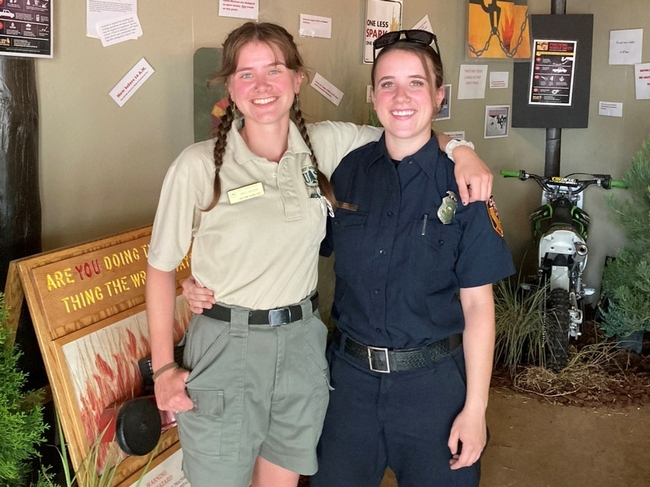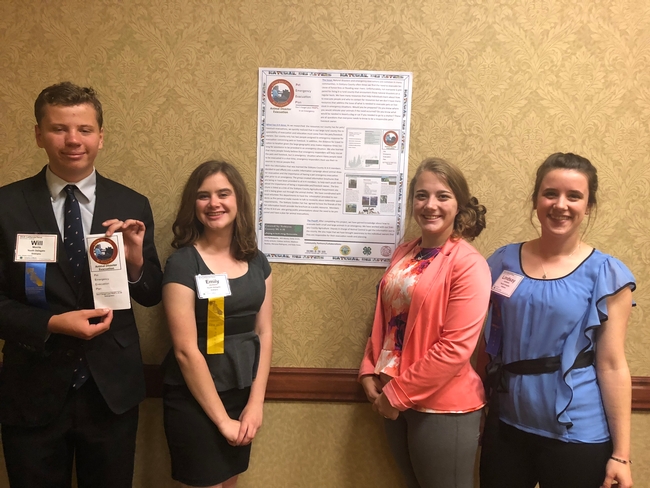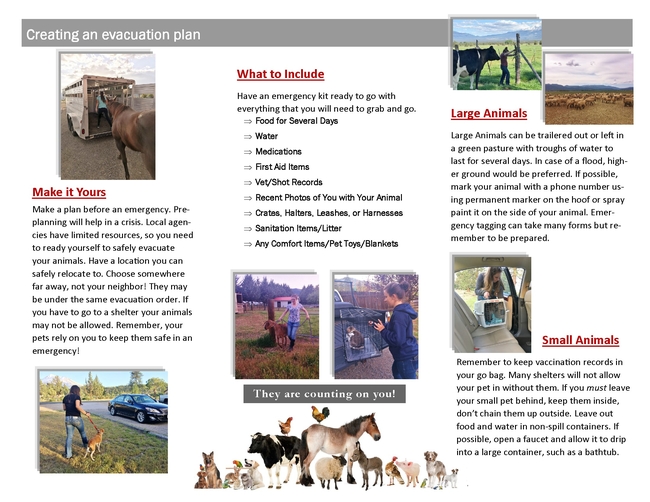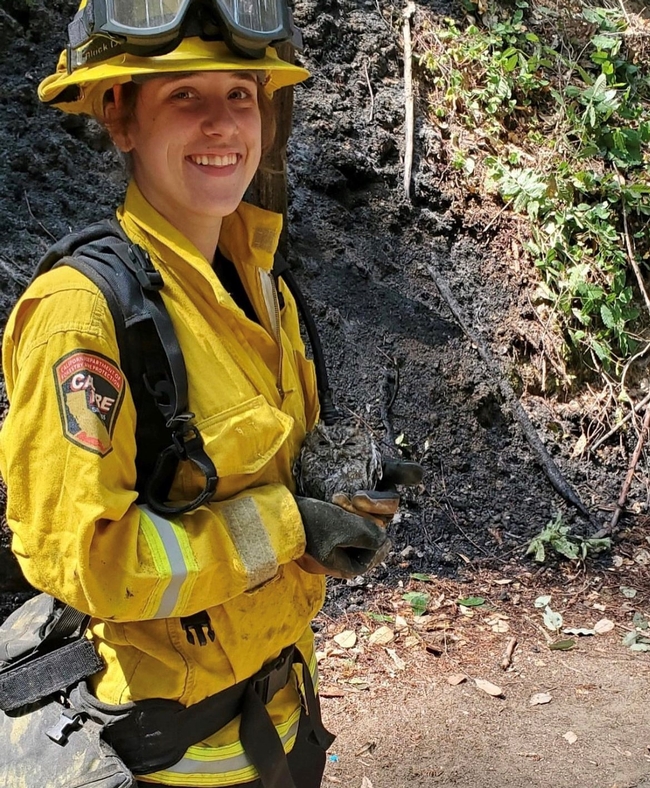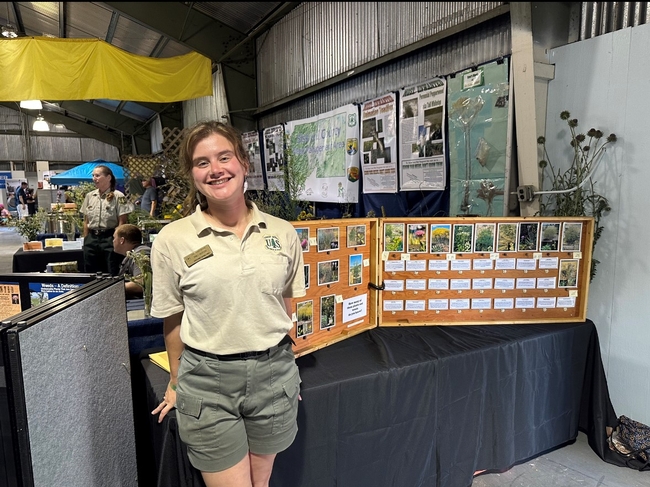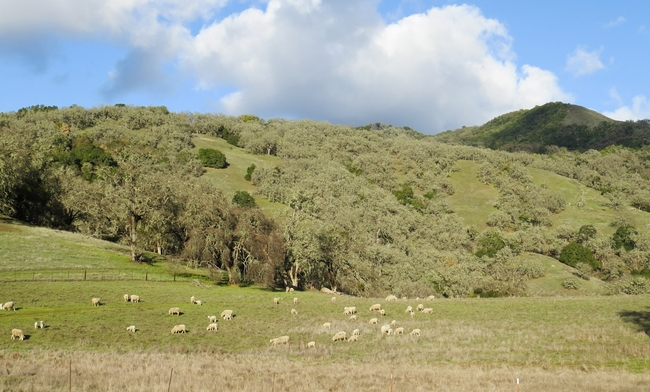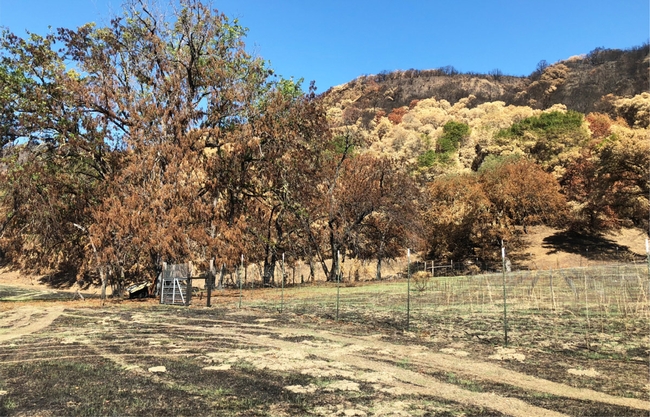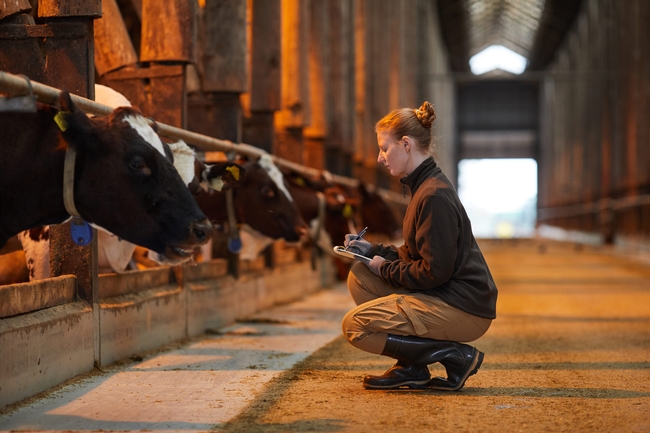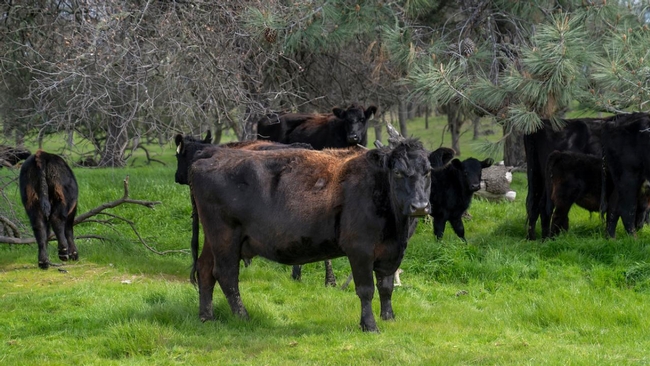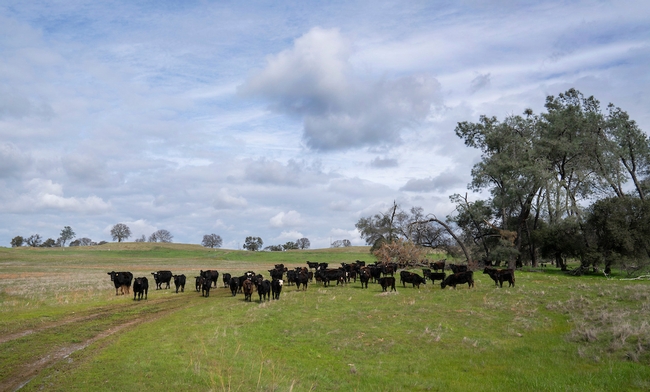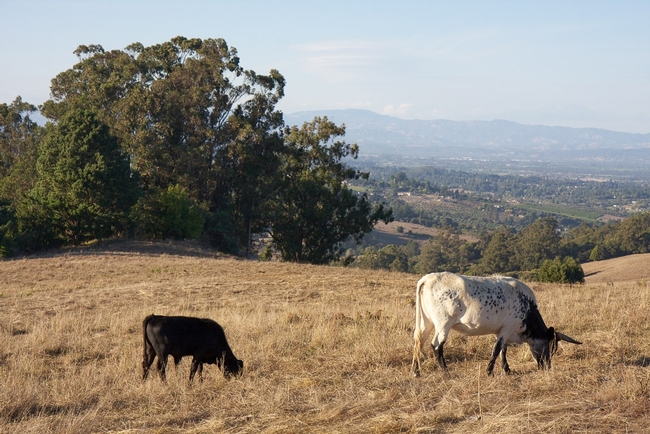Posts Tagged: livestock
4-H youth project helps Siskiyou County prepare animals for emergencies
Planning brochure for pets, livestock fills crucial need as fires an increasing threat
With the McKinney Fire creeping closer to Yreka in the summer of 2022, Emily Jackson and her mother potentially faced the enormous task of getting all their goats, chickens, dogs and cats to safety – while Emily's father and twin sister Lindsay were away fighting the fires.
Fortunately, Emily and Lindsay had gained crucial knowledge about evacuating animals through a 4-H service-learning project they helped lead in 2018. A group of eight 4-H youths, ages 14 to 18, had created a “Pet Emergency Evacuation Plan” (PEEP) brochure, aimed at educating their neighbors in Siskiyou County about the necessary preparations for livestock and pets.
The brochure, available through the Siskiyou County website, remains in use today in this densely forested region that saw another spate of wildfires this summer. The PEEP project team was composed of Kylie Daws, Emily Jackson, Lindsay Jackson, Will Morris, Madison Restine, Maryssa Rodriguez, Emily Smith and Callahan Zediker.
Within those stressful hours in 2022 when the McKinney Fire prompted an evacuation warning during which residents could be required to leave at any moment, Emily Jackson said she and her mother had a game plan in place – thanks to her work on the PEEP project.
“At the time, it wasn't even on my mind,” Jackson said, “but looking back now, I know that having the experience from making that brochure was driving my thought process at the time.”
And while the Jackson family and their neighbors ultimately were not asked to evacuate in 2022, many community members have benefited from the hundreds of copies of the PEEP brochure in circulation, which prompts residents to at least think about what their animals would need in an emergency, Jackson said.
Pet and livestock evacuation tips were needed
Such a resource previously had not been available among the county's emergency preparation materials, according to Jacki Zediker, the 4-H regional program coordinator in Siskiyou County who advised the PEEP project group.
“One piece that was missing was how to help our communities understand that when they evacuate, and they take their pets with them…it's not as simple as just taking their pets with them,” said Zediker, citing the example that some shelters do not take in animals – or do not take animals without proof of vaccination.
Other items to add to the pet's emergency kit include food for several days, water, medications, comfort items or toys, and recent photos of the owner with their animal (proof of ownership).
Zediker had connected the young people with Jodi Aceves, senior deputy agriculture commissioner/sealer for Siskiyou County, who had been overseeing the county's Animal Control programs and emergency response.
“There's a lot of information out there for people evacuating, but not necessarily for livestock and pets,” Aceves said. “Unfortunately, we have had some fires where there were lots of pets and livestock lost.”
She met several times with the 4-H group, discussing the county's evacuation systems and processes and the role of the Office of Emergency Services and law enforcement agencies, and sharing key considerations in preparing for emergencies – such as having a pre-agreement in place with someone who could house an evacuee's animals.
Aceves praised the teens for distilling the vital information into a short and simple brochure that community members could easily read and remember. She also was impressed by the energy and genuine care that the young people put into the project.
“Most of their lives, every summer, they've been in fire,” Aceves said. “It's close to their hearts, and they've seen a lot of their neighbors and other people in the county either affected by fire or evacuated at some point.”
For Lindsay Jackson, in particular, fire and serving the community have been lifelong passions, inspired by her father's work in the area.
“My dad was a volunteer fire chief for the South Yreka Fire Department; he was doing that since I was about two or three, so I grew up watching him go to the trainings, go to a call,” she explained. “When I was 15, I joined the fire department as a cadet to help out with the medical side, but the more I volunteered, I really liked the fire side, too.”
Jackson added that Zediker has a special knack for nurturing and encouraging the interests of the 4-H participants and applying them in a productive way.
“Jacki was really good at figuring out where our passions were and then how we could put our passions into a service-learning project,” she said. “She knew I was really big into fire and helping the community in that way since I was young.”
Zediker also helped the Jackson twins on their senior project, a fire-safety field day at the South Yreka fire station. More than 100 schoolchildren learned fire safety basics, met firefighters and emergency personnel, and heard about 4-H from Lindsay and Emily.
4-H experiences, mentorship inspire career paths
The PEEP project group also was asked by several organizations to share their knowledge about emergency preparations for animals. In addition to presenting a poster about their work at the 4-H California Focus conference in 2018, the group handed out the brochure and shared information at a table during a Juniper Flat Fire Safe Council workshop and resource fair.
Beyond distributing the PEEP brochure at 4-H club meetings, school events and community meetings, the youths have lent their voices to advocating for emergency resources for animals. Zediker noted that they contributed testimonials that helped the county acquire grants for purchasing more portable kennels.
But the most enduring impact of 4-H participation and community service, however, is that those experiences were a springboard for the young adults' careers. Emily Jackson – who participated in 4-H from age 5 to 19 – is now working toward a master's degree in biology at Cal Poly Humboldt, studying how fire suppression and other factors have changed plant communities in the Russian Wilderness.
Whether training colleagues as a U.S. Forest Service crew lead for the past couple of summers, or leading lab sections in general botany as a graduate student, Jackson said she draws on her 4-H experiences – and Zediker's inspirational example – as she pursues a career in teaching.
“In my development as a young adult into an adult now, I cannot overstate how big of a role Jacki played in that,” Jackson said.
Her sister Lindsay, meanwhile, has pursued her passion for fire all the way through the fire academy at College of the Siskiyous, where she also earned her emergency medical technician (EMT) license. Most recently working on fires near Pondosa in Siskiyou County, Jackson has been a seasonal firefighter based at the McCloud CAL FIRE station since 2020.
“It's hard because, in the last three years, I haven't left Siskiyou County, there's just been so many fires here,” she said. “But it's nice being able to help your community and know you're making a difference.”
Lindsay Jackson intends to pursue a bachelor's degree in leadership studies at Cal Poly Humboldt in hopes of getting a full-time position with CAL FIRE.
Lambs grazing on pastures after wildfire show no significant adverse effects
Hopland REC turns 2018 River Fire devastation into research opportunity
The destructiveness of wildfire flames is easy to see, but dangers may lurk in the ashes they leave behind. A group of UC Davis scientists studied lambs at the UC Hopland Research and Extension Center, investigating whether pastures regrown after a wildfire cause toxic metal residues in grazing animals. The results, published in California Agriculture journal, showed that grazing on regrown pastures did not significantly alter the metal content of the lambs' meat and wool. That's good news for ranchers and consumers from a food safety perspective.
In 2018, the River Fire burned six miles north of Hopland, scorching two-thirds of the land at Hopland REC, including areas in its sheep station. Since Hopland REC conducts ecological and agricultural research, they had data and some meat samples from the sheep flock that lived on site before the River Fire occurred.
“A bunch of researchers came together to brainstorm how we could take advantage of this unfortunate event,” said Sarah Depenbrock, assistant professor and agronomist in the Medicine and Epidemiology department of UC Davis School of Veterinary Medicine.
Burning has played a role in agricultural processes for many years, but wildfires in California are creating a new fire landscape that interests researchers like Depenbrock. “The problem, now, is that these big wildfires probably interact with agricultural land differently than routine prescribed burns,” she said.
Large, older plants on lands that have not recently burned may contain high concentrations of metals, sequestered over years of growth. Mercury is an example of a potentially dangerous metal that can be sequestered in living things over time. These metals may be distributed in ash after the vegetation burns so the scientists examined lambs that had grazed on Hopland REC's recently burned pastures, during the first plant regrowth.
Uncertain results raise more questions
The researchers compared meat from lambs that grazed on regrown pastures in 2019, after the River Fire, to frozen meat samples that were collected the year before the fire. Lead, mercury, arsenic, molybdenum, cadmium, beryllium, cobalt and nickel were not detected in any animal samples. There were, however, a few (3 out of 26) samples that tested positive for the non-essential (potentially toxic heavy metals) chromium and thallium in the group grazing after the fire.
Due to the small number of samples testing positive, researchers could not determine statistically if this contamination was associated with grazing the burn regrowth. The concentrations of chromium and thallium found may or may not be potentially toxic, depending on the specific forms and how much meat a person consumes.
Another aspect of the study included testing lambs' wool to determine if it is a good method of judging the mineral content of its meat. “In general, we learned that it wasn't well-correlated with most meat metal content of interest, which is worth knowing. However, because we did not identify many of the non-essential metals of particular toxologic concern, such as lead or mercury, in any animal samples we could not determine if testing wool would be useful for those metals, as they are in other species,” said Depenbrock. She also notes that the wool from animals whose meat tested positive for chromium and thallium, did not test positive for these metals in their wool.
As the challenges in managing wildfires persist, so does the risk of contamination of food products stemming from grazing livestock.
“We didn't get striking evidence that tells us, when there's a fire, it means everything is contaminated with heavy metals,” said Depenbrock. “But it does raise the question that maybe we should be doing a little bit of surveillance to see if this is spurious or common. And we should be finding a way to screen grazing herds.”
Recommendations to manage copper concerns
“It's a very small study, but it was quite interesting to find that copper was actually lower in the postfire grazing group, which makes me wonder,” Depenbrock said.
Diseases associated with copper deficiency are a major concern in sheep. For example, congenital swayback can result in stillbirth or an animal's inability to stand on its own due to incurable changes to the spinal cord. Other adverse effects include reduced growth rate, anemia, wool defects and fiber depigmentation, and osteoporosis with higher risk of spontaneous fractures. Copper excess can also cause serious and sometimes fatal disease.
Many of the forage sources, grazing areas and rangelands in California are copper deficient, while some feed sources have excess copper. Screening and monitoring livestock herds for trace minerals including copper is crucial.
To test for copper, she advises livestock owners to obtain mineral concentrations from the organs of euthanized or dead animals. Samples from the liver and kidney are the most valuable organs to identify a potential problem in the herd. UC Davis Veterinary Medicine's California Animal Health and Food Safety (CAHFS) labs do this testing routinely.
Second, monitor and record mineral supplementation and, third, maintain updated health records to make informed decisions regarding supplementation based on a herd or flock's known problems. For example, if a producer is not accustomed to supplementing copper, Depenbrock highly recommends working with a veterinarian to start out (as there are numerous copper supplement products of varying concentration on the market), to determine a testing or screening plan, and review health records for problems potentially associated with copper.
To read the full text of the study, visit https://calag.ucanr.edu/Archive/?article=ca.2022a0016.
Dairy Industry Innovation Assessment Tool identifies most promising solutions
The Hague, NL – The dairy industry in both California and the Netherlands faces four major challenges: manure management, enteric methane, labor, and sustainability measurements and standards. To identify existing and emerging market solutions and assess the impact of these solutions across the four categories and animal welfare, an innovation assessment tool has been created.
The VINE, an initiative of the University of California Agriculture and Natural Resources, and Wageningen Livestock Research - Dairy Campus have released their novel Global Dairy Industry Innovation Assessment Tool. This tool is the first step in a joint dairy collaborative aimed at promoting sustainable, climate-smart agriculture for a better future.
"The partnership between The VINE and Wageningen Livestock Research - Dairy Campus has enabled us to combine our expertise and insights to create an overview of these key challenges and opportunities for the dairy industry,” said Gabe Youtsey, chief innovation officer for UC ANR. “Understanding this landscape of innovation allows us to leverage our shared resources to support and drive the commercialization of solutions.”
“Innovation is key for the future development of the dairy sector in both countries” said Kees de Koning, manager Innovation at Dairy Campus.
This tool provides a snapshot of the current state of innovation addressing some of the challenges in the dairy industry, showcasing innovative technologies and products that are, or have the potential to, make a difference on a global scale. By identifying the most promising solutions and encouraging collaboration among key industry players, the team aims to drive further progress toward a sustainable dairy industry.
The database lists companies, identifies which challenges their product addresses and ranks the maturity of the product from “proof of concept” to “mature.”
“This Global Dairy Industry Innovation Assessment Tool is designed to give insights on the opportunities and tradeoffs inherent in deploying any new technology,” said Mareese Keane, co-founder of Opengate and partner of The VINE. “It is a living database and any companies that want to add or update their entry are invited to get in touch."
To complement the assessment tool, The Vine and Wageningen dairy collaboration are working on the following projects:
- Building Blocks for Virtual Future Farm: Envisioning a theoretical farm with zero emissions or maximum circularity by leveraging Dutch precision technology and California large-scale farming expertise.
- The VINE VIP (Validation of Innovations Project): Focusing first on value-added products from manure, participants will look for technologies that provide value-added products at scale from manure, beyond energy and direct application as fertilizer.
- A delegation of California-based dairy industry innovators and operators are invited to join an innovation tour of the Dutch dairy industry, starting Nov. 6.
Click here to view the Dairy Innovation Assessment Tool: https://airtable.com/shrMIHqbWNnwhJs8y/tblN8IzvBQ5kAwSou
For more information about the Dairy Innovation Assessment Tool, how the companies included were selected, and how to submit or update additional entries, please visit https://thevine.io/towards-better-dairy-global-innovation-landscape.
About The VINE: The VINE, an initiative of the University of California, Agriculture and Natural Resources, is California's agriculture, food and biotech innovation network. The VINE aims to harness the power of open innovation to help industries and entrepreneurs grow and scale globally while catalyzing technology innovation and commercialization for productive, sustainable, and equitable food systems.
About Wageningen Livestock Research - Dairy Campus: Wageningen Dairy Campus is a leading research institution in the Netherlands focused on dairy farming and sustainability. The Dairy Campus provides a platform for education, research and innovation, bringing together industry partners, academi, and government organizations to advance sustainable practices in the dairy sector.
California’s local meat suppliers struggle to stay in business
UC Davis report suggests ways to build resilience
The University of California, Davis, Food Systems Lab has released a white paper showing the need to support California's small and mid-scale meat suppliers and processors in order to build a more resilient meat supply chain. It describes how the meat supply chain and rural economies could benefit from regulatory changes and more collaboration among producers and other stakeholders in the system.
The pandemic shut down meat processing plants in 2020, as did recent ransomware attacks on JBS, the nation's largest meat supplier. Report authors said this highlights the need to support small- and mid-scale suppliers.
“COVID and the ransomware attacks put a spotlight on how the concentration of the meat supply chain increased vulnerability in the food system,” said report co-author Tom Tomich, founder of the UC Davis Food Systems Lab and distinguished professor in the Department of Environmental Science and Policy. “We need to level the playing field so small- and mid-scale farms have an easier way to bring their product to market.”
The report says the lack of access to slaughter facilities, limited capacity of cut and wrap facilities, and concentration of marketing channels create conditions in which small- and mid-scale farms and ranches struggle to stay in business.
“These challenges are exacerbated by policies that tilt the playing field against small operators. Fortunately, new state and national legislation and programs are developing that could increase resilience in our food systems,” says Michael R. Dimock, Roots of Change program director and lead author for the report. “We need cities and counties to help fix the problems because local land use policies often impede development of resilient supply chains.”
Lack of access and limited capacity
Smaller ranchers in California have limited access to slaughter and processing facilities. In the last 50 years, California has lost half of its federally inspected meat processing plants, and the remaining facilities are unable to meet demand. Many of the 46 USDA-certified slaughter plants operating in California are closed to smaller producers.
“This means that smaller ranchers must drive hundreds of miles to reach a facility or have to wait months due to limited capacity,” said Tomich.
The report said a combination of federal, state and private investments could provide a broader geographic distribution of plants of differing scales. It also suggests expanding mobile, on-farm slaughter operations for sheep, goats and hogs, similar to those for beef.
Regulatory barriers and opportunities
Complex inspection requirements and other regulatory barriers make it difficult for small- and mid-scale producers to compete with big suppliers. The report suggests California create its own meat inspection program equivalent to the federal program to serve smaller ranchers. Prioritizing public procurement of local, high-value meat would also help expand market access for smaller producers.
Broader benefits of smaller operators
The report notes other beneficial roles of small- and mid-scale livestock operations, apart from the potential to increase resilience in our food system. Livestock grazing is a cheap and effective way to reduce wildfire risk. Supporting local meat processing also helps rural economies and creates community-based jobs.
The report was based on 27 interviews with people representing a wide spectrum of activities and points of view within the meat supply chain throughout the state. Authors are Courtney Riggle, Allan Hollander, Patrick Huber and Thomas Tomich of the UC Davis Food Systems Lab, and Michael R. Dimock with Roots of Change.
Funding for the study came from the TomKat Foundation and USDA Hatch Program.
Cattle grazing is a tool for reducing fire danger
Cattle can help reduce wildfire danger by grazing on fine fuels in rangeland and forest landscapes, reported Sierra Dawn McClain in Capital Press. The article also appeared in the Blue Mountain Eagle, the Westerner and the East Oregonian.
The article cited the preliminary results of research by UC Cooperative Extension that show that cattle consumed approximately 12.4 billion pounds of forage across California in 2017. The researchers believe the cattle could do more.
Many grazable acres aren't grazed, said Sheila Barry, UCCE livestock and natural resources advisor in Santa Clara, San Mateo, Alameda and Contra Costa counties. According to the Capital Press article, Barry said the public doesn't always recognize the benefits of grazing; they see short grass and cow patties. Cattle's role in preventing wildfires is often overlooked.
Devii Rao, UCCE livestock and natural resources advisor for San Benito, Monterey and Santa Cruz counties and the study's lead, said ranchers should target grazing around homes, infrastructure, roadsides and at the wildland-urban interface.
“There are so many things we can do better. Cattle grazing is really important to fire safety, and it's time we have more conversations about it,” Rao said.

